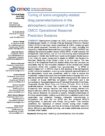Starting from October 1st, 2020, a new version of the Euro- Mediterranean Center on Climate Change Seasonal Prediction System (CMCC-SPS3.5) has been made operational at CMCC, producing each month global seasonal forecasts for a variety of users, including the Copernicus Multi-Model Seasonal Prediction System. CMCC-SPS3.5 has replaced the previous system version CMCC-SPS3. In both systems, the atmospheric, land surface, sea ice and river routing model components are based on CESM, the NCAR Community Earth System Model version 1.2.2, while the ocean component is based on NEMO, the Nucleus for European Modelling of the Ocean model, in its 3.4 version. The new version of the Seasonal Prediction System differs from the previous one essentially only for the horizontal resolution of the atmospheric model component (CAM 5.3), doubled from approximately 1° in SPS3 to approximately 0.5° in SPS3.5. Due to this doubling of the atmospheric model horizontal resolution, re-tuning some physical parametrizations of the atmospheric model was considered useful in order to reduce the model bias, mostly on the zonal flow and lower and mid-tropospheric, mid- latitude dynamical fields. The re-tuning effort was based on the results of a number of 5-year AMIP-like simulations (1981-1985) and it did concentrate on the parameterizations of Turbulent Orographic Form Drag, Orographic Gravity Wave Drag and Vertical Diffusion. Each of these parameterizations schemes has considerable influence on vertical momentum (and energy) transport and they all strongly interact non linearly with each other via, among other things, changing the mean flow. They cannot, therefore, be re-tuned singularly. Several combinations of the three parametrization settings were tried until a satisfactory set of new parameters was achieved, showing noticeable improvements in comparison with both the old SPS3 and the un-tuned SPS3.5 configurations, in particular over Europe during winter. This exercise underlines the importance of climate models’ tuning when models’ characteristics are changed, and how an increase in horizontal resolution alone, without an appropriate re-tuning, can create unbalances and even increase model biases.
CMCC Divisions


